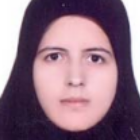
Hadis Heidari
Work place: Department of Computer Engineering, Razi University, Kermanshah, Iran
E-mail: h.heidari@pgs.razi.ac.ir
Website:
Research Interests: Operating Systems, Image Compression, Image Manipulation, Computer Networks, Image Processing, Computing Platform
Biography
Hadis Heidari is currently a M.Sc. student in Razi University of Kermanshah, Iran. She obtained her B.S. in Computer Engineering from the same University in 2011. She was the first rank of students in Computer Engineering in the Razi University. Her research interests are in the fields of operating systems, computer networks, reconfigurable computing and image processing.
Author Articles
Parallel Implementation of Color Based Image Retrieval Using CUDA on the GPU
By Hadis Heidari Abdolah Chalechale Alireza Ahmadi Mohammadabadi
DOI: https://doi.org/10.5815/ijitcs.2014.01.04, Pub. Date: 8 Dec. 2013
Most image processing algorithms are inherently parallel, so multithreading processors are suitable in such applications. In huge image databases, image processing takes very long time for run on a single core processor because of single thread execution of algorithms. Graphical Processors Units (GPU) is more common in most image processing applications due to multithread execution of algorithms, programmability and low cost. In this paper we implement color based image retrieval system in parallel using Compute Unified Device Architecture (CUDA) programming model to run on GPU. The main goal of this research work is to parallelize the process of color based image retrieval through color moments; also whole process is much faster than normal. Our work uses extensive usage of highly multithreaded architecture of multi-cored GPU. An efficient use of shared memory is needed to optimize parallel reduction in CUDA. We evaluated the retrieval of the proposed technique using Recall, Precision, and Average Precision measures. Experimental results showed that parallel implementation led to an average speed up of 6.305×over the serial implementation when running on a NVIDIA GPU GeForce 610M. The average Precision and the average Recall of presented method are 53.84% and 55.00% respectively.
[...] Read more.Analysis of Reconfigurable Processors Using Petri Net
DOI: https://doi.org/10.5815/ijcnis.2013.09.04, Pub. Date: 8 Jul. 2013
In this paper, we propose Petri net models for processing elements. The processing elements include: a general-purpose processor (GPP), a reconfigurable element (RE), and a hybrid element (combining a GPP with an RE). The models consist of many transitions and places. The model and associated analysis methods provide a promising tool for modeling and performance evaluation of reconfigurable processors. The model is demonstrated by considering a simple example. This paper describes the development of a reconfigurable processor; the developed system is based on the Petri net concept. Petri nets are becoming suitable as a formal model for hardware system design. Designers can use Petri net as a modeling language to perform high level analysis of complex processors designs processing chips. The simulation does with PIPEv4.1 simulator. The simulation results show that Petri net state spaces are bounded and safe and have not deadlock and the average of number tokens in first token is 0.9901 seconds. In these models, there are only 5% errors; also the analysis time in these models is 0.016 seconds.
[...] Read more.Parallel Implementation of Texture Based Image Retrieval on The GPU
By Hadis Heidari Abdolah Chalechale Alireza Ahmadi Mohammadabadi
DOI: https://doi.org/10.5815/ijigsp.2013.09.06, Pub. Date: 8 Jul. 2013
Most image processing algorithms are inherently parallel, so multithreading processors are suitable in such applications. In huge image databases, image processing takes very long time for run on a single core processor because of single thread execution of algorithms. Graphical Processors Units (GPU) is more common in most image processing applications due to multithread execution of algorithms, programmability and low cost. In this paper we implement texture based image retrieval system in parallel using Compute Unified Device Architecture (CUDA) programming model to run on GPU. The main goal of this research work is to parallelize the process of texture based image retrieval through entropy, standard deviation, and local range, also whole process is much faster than normal. Our work uses extensive usage of highly multithreaded architecture of multi-cored GPU. We evaluated the retrieval of the proposed technique using Recall, Precision, and Average Precision measures. Experimental results showed that parallel implementation led to an average speed up of 140.046×over the serial implementation. The average Precision and the average Recall of presented method are 39.67% and 55.00% respectively.
[...] Read more.Other Articles
Subscribe to receive issue release notifications and newsletters from MECS Press journals